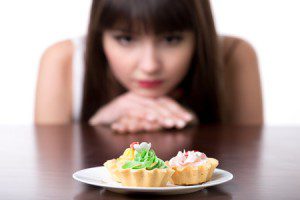With Halloween and the holidays approaching, you might be wondering how to stop sugar cravings dead in their tracks. After all, October 31 seems to be a day filled with devious tricks disguised as delicious treats. Taking a peanut butter cup from the stash meant for the day’s doorbell ringers or sneaking some sweet taffy when your kiddos head to bed may seem harmless enough, but in reality, it’s the start to a whole lot of sugar craving problems.
Even before the gateway holiday hit, you may have noticed an increased hankering for sugar after eating sugar or simple carbs. For example, after starting the morning with a great big pre-made blueberry muffin nearly large enough for a family of four, two hours later and your stomach is making a racket wanting more. Same happens after a sugary afternoon pick-me-up that only seems to sink you deeper in your midday slump.
Sugar is Not So Sweet for Health
Annoying cravings aside, sugar comes with lots of other negative side effects–weight gain, risk for diabetes, increase in blood pressure, and the list goes on. The American Heart Association recommends no more than six teaspoons (25 grams) of added sugar for women per day. This is similar to World Health Organization’s recommendations of less than 5 percent of an adult’s calories (equating to six teaspoons or 25 grams) should come by way of added sugars. Still, Americans are consuming nearly 20 teaspoons (82 grams) of sugar per day–66 pounds per person per year.
Eating Sugar Means Craving Sugar
There are a few reasons why we have such a hard time walking away from the sweet stuff. First, it’s delicious. Research shows that sugar affects your tastebuds. In one study, 20 people were asked to cut out all foods and drinks with added sugars and artificial sweeteners for two weeks. When the sugar detox was done, 95 percent of the participants found the sweet foods and drinks they used to eat now tasted sweeter–or even too sweet.

Second, it’s addictive–like getting hooked on hardcore drugs kind-of addictive. Similar to the effects of using heroin or cocaine, research shows that sugar stimulates the same pleasure centers of the brain. Cravings and withdrawals are normal when hooked on the sweet stuff.
Third, it’s hiding in places you might not expect. Sure, that fudgy brownie is a known a pack mule for sugar, but things like pasta sauce, granola, yogurt and other seemingly “healthy” pre-prepared foods are smuggling the white stuff, too. Your cravings may exist because you’re taking in sugar without even being aware of it.
How to Stop Sugar Cravings
Taking a break from desserts and walking away from the candy is an obvious first step, but it’s sometimes not that easy–especially when the cravings make you crazy ravenous for anything sweet. A better choice might be to go cold turkey with a sugar detox. That means cutting added sugars–and artificial sweeteners (as your brain doesn’t always know the difference)–for a period of time. Research shows that most people who cut sugar for two weeks felt no cravings after six days. In those six days, remember that your body may go through a bit of a withdrawal, leaving you with headaches, dizziness, or a general sense of feeling off. Push lots of water during this time can help. Additionally, try these tips:
- Eat fruit–don’t drink it. Fruit juice packs a lot of sugar, so skip the liquid and grab a piece of fruit when you need something sweet. It satisfies the craving, and the boost of fiber is always a bonus.
- The darker the chocolate the better. You don’t have to ditch chocolate when detoxing from sugar, just up the cocoa level. Dark chocolate tends to have a lot less added sugar and is a great treat when you’re wanting a candy bar.
- Read the labels. Don’t let sugar sneak into your meals without you knowing. Always check labels for sugars and other ingredients ending in “ose.” You can steer clear of a lot of added sugar by making dishes from scratch and avoiding processed and pre-packaged foods.
- Have a Plan B. When sugar cravings kick in, it can be easy to feel overwhelmed and just give in. Put a plan in place to know how to deal with them before they hit. For example, keep a non-sugary snack on hand or let your cravings act as a reminder to go for a walk.
- Stay hydrated. You brain sometimes misinterprets thirst for hunger. When a sugar craving kicks in, it may just be your body’s way of telling you it’s thirsty. Drink plenty of water throughout the day to keep the sugar cravings at bay.
How do you deal with sugar cravings? Share with others in the comments.
Resources:
Study: Does Consuming Sugar and Artificial Sweeteners Change Taste Preferences?


Leave a Reply